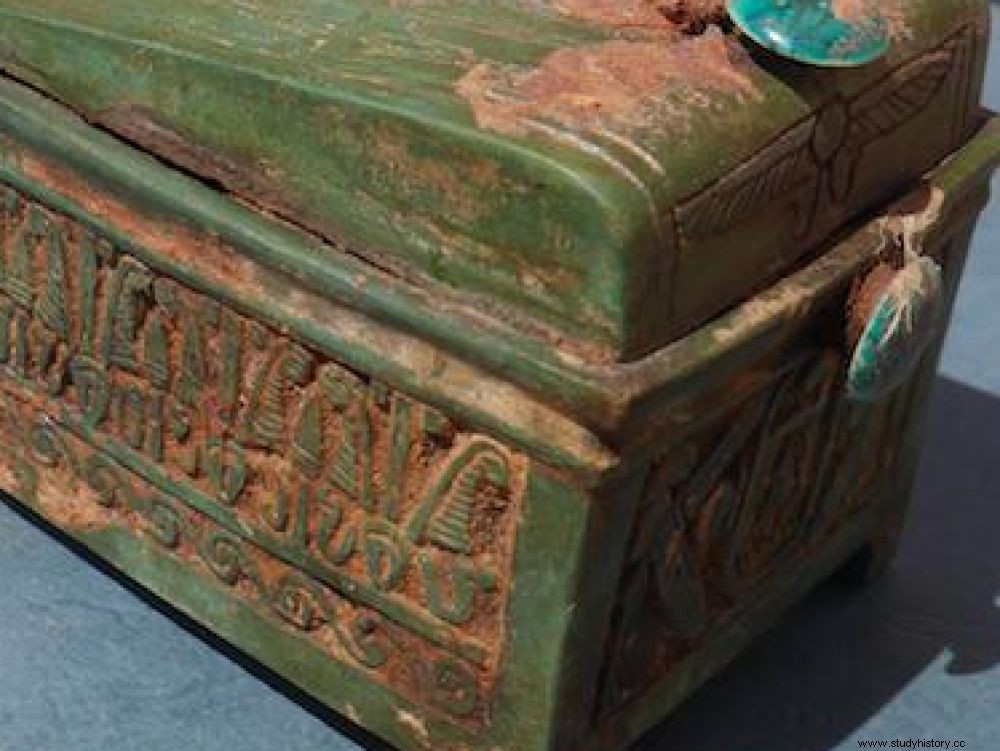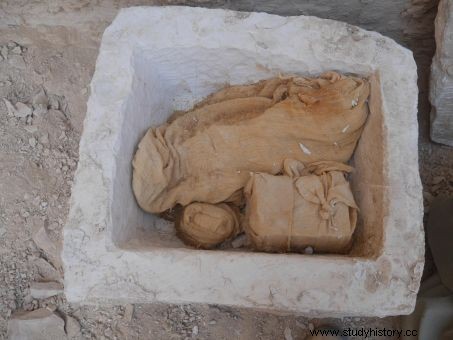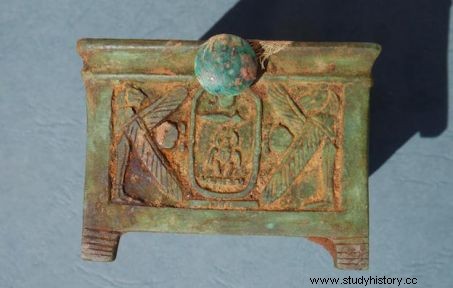A 3,500-year-old ancient casket containing intriguing offerings has been found in the region of Deir el-Bahari, a complex of temples and tombs, located on the left bank of the Nile, facing Luxor, in Egypt. It could signal the presence of an as yet unidentified royal tomb.

Enamel box decorated with royal symbols of Upper and Lower Egypt.
The remains of a whole goose, eggs, decorated chests... This is a surprising discovery made by a team of Polish researchers, in the pink limestone cliffs of the Theban mountains, in Deir el-Bahari, Egypt . This place is famous for hosting the huge temple of Queen Hatshepsut (circa 1508-1458 BC), one of the most remarkable monuments of the New Kingdom (1570-1070 BC). Better ! During their excavations in this same area, archaeologists from the Polish Cliffs Mission* unearthed a casket bearing titles attributed to the husband of this 18th dynasty queen, Pharaoh Thutmose II (1510-1470 BC). It was under heaps of stone blocks artificially amassed along this cliff during antiquity. So many discoveries that could lead to a royal hypogeum! "We revealed this news during the 12 e International Congress of Egyptology held in Cairo in the fall of 2019, explains to Sciences et Avenir, enthusiastic, Professor Andrzej Niwiński of the Institute of Archeology of the University of Warsaw (Poland), responsible for this work. This funerary deposit indicates the probable proximity of a temple or a tomb related to this king."
A goose, eggs and a king beetle
It was a cavity carved into the rock that first appeared to archaeologists, before a chest emerged that researchers initially mistook for a vulgar block of stone. Before they discover, inside, three "packages", each covered with a linen cloth. The largest contained the remains of a goose, the second, an egg of the bird, and the third, carefully wrapped and tied with a linen cord, a wooden box, protecting an ibis egg, another sacred bird.

Mistaken upon discovery for a mere block of stone, this mineral chest was found to contain royal offerings. Credits:Polish Cliff Mission
"Nearby, we also collected a miniature pottery, as well as a second package swaddled in four linen cloths. These objects are frequently found in foundation deposits" , continues the Polish specialist. What the textile envelope protected was a wooden box, this time oval in shape, on the lid of which was carved a beetle. The symbol of Re, sun god creator of the Universe among the ancient Egyptians. Once opened, appeared another textile packaging of the finest linen. It concealed an earthenware box, near which were fragments of royal seals. On the sides, spiral decorations, feathers and a cobra snake, the protective animal of the pharaoh. They were separated by lotus buds, another heraldic symbol of pharaonic Egypt. In the back, a falcon held signs of eternity between its talons. "The most important is the front facing of the casket. Between female lion-headed figures, probably representing the goddesses Isis and Nephthys, is the cartouche of the pharaoh Thutmose II" , adds Andrzej Niwiński. This case housed a linen shroud enveloping a beetle of the species Scarabeus sacer , the sacred beetle.

Between the goddesses Isis and Nephthys, the cartouche of Pharaoh Thutmose II. Credits:Polish Cliff Mission
The mummy of this pharaoh has never been found, nor his tomb. Contrary to what might have been said in the past, she was not among the set of royal mummies found in the 19th century, concealed in the "hiding place* of Deir el-Bahari", as demonstrated in 1987 by the French Egyptologist Luc Gabolde (CNRS). These mummies had been hastily hidden by priests of Amun around 1000 BC to escape looting. "There is a good chance that we are approaching the entrance to the tomb of Thutmose II..." , begins to hope Andrzej Niwiński.
*Polish Cliff Mission.
Hide of the royal mummies of Deir el-Bahari
In 1871, a family from Gournah, the Abd el-Rasuls , discovered a tomb in Deir el-Bahari (Egypt) from which they immediately sold the funerary objects and figurines on the Antiques market. In 1881, following an investigation carried out on the site by Gaston Maspero, of the Egyptian Antiquities Conservation Service, around thirty royal mummies from the 18th and 21st Dynasties were found, gathered in a "cache", a tomb composed of 3 chambers. Carved into the Theban Mountain, above the temples, the place was used for 3000 years to hide these mummies to preserve them from the looting of royal tombs which had taken place around 1000 BC.
